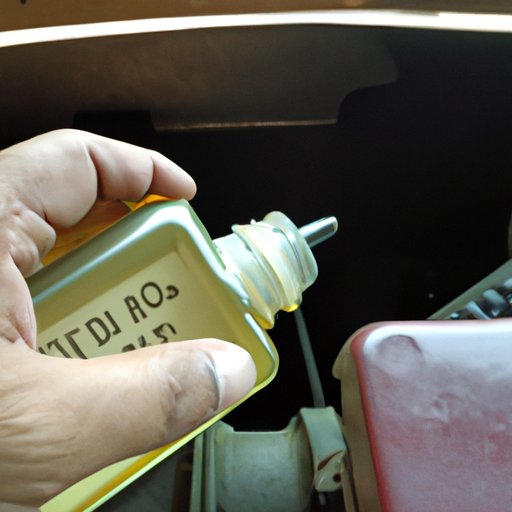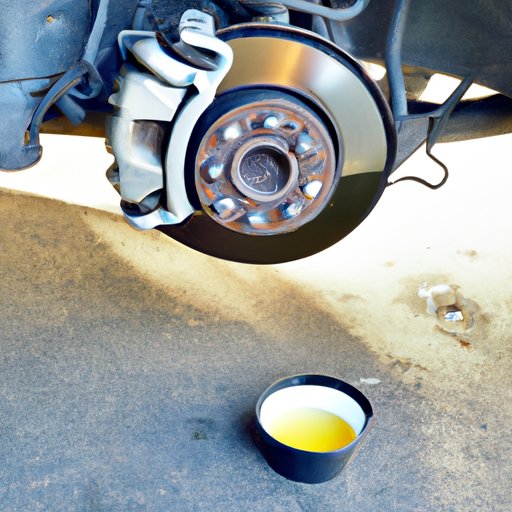Introduction
Brake fluid is an essential component for a car’s brake system. It is a hydraulic fluid that transmits pressure from the brake pedal through the brake lines to the brakes themselves. In this article, we’ll explore the basics of brake fluid and how it works, as well as its components, benefits, types, and importance for vehicle safety. We’ll also discuss how to test and replace brake fluid, and what to do about common problems.

Explaining the Basics of Brake Fluid and How It Works
What is brake fluid? Brake fluid is a type of hydraulic fluid used in automobiles to transfer pressure from the brake pedal to the brakes. It is a non-compressible liquid that is stored in a master cylinder located under the hood of the vehicle. When the brake pedal is pressed, the fluid is forced through the brake lines to the brakes, causing them to activate and slow down or stop the vehicle.
How does it work? When the brake pedal is pressed, the force from the driver’s foot is transferred to the master cylinder, which is filled with brake fluid. This causes the pressure of the brake fluid to increase and flow through the brake lines to the brakes. The increased pressure forces the brakes to activate and slow down or stop the vehicle.
The Components of Brake Fluid and Its Benefits
What are the components of brake fluid? Brake fluid is composed of a mixture of glycol and polymers, as well as various additives that help reduce wear and tear on the brake system. These additives can also help protect against corrosion and oxidation, which can damage the system over time.
What are the benefits of using brake fluid? The primary benefit of brake fluid is that it helps to keep the brake system operating smoothly. It also helps to reduce wear and tear on the system, as well as protect against corrosion and oxidation. Additionally, brake fluid helps to maintain the integrity of the brake system, ensuring that it is capable of stopping the vehicle when needed.

Types of Brake Fluid and How They Function
What are the types of brake fluid? There are three main types of brake fluid: DOT 3, DOT 4, and DOT 5. Each type has different properties that make it suitable for different applications. For example, DOT 3 brake fluid is the most commonly used type and is suitable for most vehicles. DOT 4 brake fluid is more resistant to heat and is typically used in high-performance vehicles. Finally, DOT 5 brake fluid is made from silicone and is not compatible with other types of brake fluid.
How do they function? All types of brake fluid perform the same basic function: transferring pressure from the brake pedal to the brakes. However, each type has different properties that make it suitable for different applications. For instance, DOT 3 brake fluid is suitable for most vehicles, while DOT 4 brake fluid is better suited for high-performance vehicles. DOT 5 brake fluid is made from silicone and is not compatible with other types of brake fluid.
Understanding the Importance of Regularly Maintaining Your Brake Fluid
Why is it important to maintain your brake fluid? Over time, brake fluid can become contaminated with dirt and moisture, which can cause the brake system to malfunction. Additionally, brake fluid can break down due to age and exposure to high temperatures, which can lead to a decrease in performance. Therefore, it is important to regularly check and maintain your brake fluid in order to ensure that your brake system is functioning properly.
How often should you check it? It is recommended that you check your brake fluid every six months or 6,000 miles, whichever comes first. Additionally, it is important to check your brake fluid before any long drives or trips. If you notice any signs of contamination or deterioration, it is important to have your brake fluid checked by a professional mechanic as soon as possible.

The Role of Brake Fluid in Keeping Your Vehicle Safe
How does brake fluid keep your vehicle safe? As mentioned above, brake fluid is responsible for transferring pressure from the brake pedal to the brakes. This ensures that the brakes can activate and slow down or stop the vehicle when necessary. Without proper brake fluid, the brakes may not be able to activate, increasing the risk of an accident.
What are the risks of not maintaining your brake fluid? Not maintaining your brake fluid can lead to a number of issues, including contamination, deterioration, and decreased performance. These issues can lead to a decrease in braking power, which can increase the risk of an accident. Additionally, if the brake fluid becomes too contaminated or deteriorated, it can cause damage to the brake system, leading to costly repairs.
How to Test and Replace Brake Fluid
How is brake fluid tested? Brake fluid can be tested using a device called a hydrometer. A hydrometer measures the amount of water in the brake fluid and indicates whether the fluid needs to be replaced. If the fluid is found to be too contaminated or deteriorated, then it should be replaced immediately.
How is brake fluid replaced? To replace brake fluid, a mechanic will use a vacuum pump to remove the old fluid from the system. Once the old fluid has been removed, the mechanic will replace it with new brake fluid. The new fluid will then be tested to ensure that it meets the manufacturer’s specifications.

Common Problems with Brake Fluid and What to Do About Them
What are some common problems with brake fluid? Some common problems with brake fluid include contamination, deterioration, and decreased performance. Contamination occurs when dirt and moisture enter the brake system, while deterioration occurs when the fluid breaks down due to age and exposure to high temperatures. Decreased performance occurs when the brake fluid is not maintained properly.
What can you do to fix these problems? If you notice any signs of contamination or deterioration, it is important to have your brake fluid checked by a professional mechanic as soon as possible. If the fluid is found to be too contaminated or deteriorated, then it should be replaced immediately. Additionally, it is important to regularly check and maintain your brake fluid in order to ensure that your brake system is functioning properly.
Conclusion
Brake fluid is an essential component for a car’s brake system. It is responsible for transferring pressure from the brake pedal to the brakes, ensuring that the brakes can activate and slow down or stop the vehicle when necessary. There are three main types of brake fluid: DOT 3, DOT 4, and DOT 5. Each type has different properties that make it suitable for different applications. It is important to regularly check and maintain your brake fluid in order to ensure that your brake system is functioning properly. If you notice any signs of contamination or deterioration, it is important to have your brake fluid checked by a professional mechanic as soon as possible.
In conclusion, brake fluid is an essential component for a car’s brake system. It is important to understand how brake fluid works and why it is important to maintain it. By understanding the basics of brake fluid and its benefits, as well as how to test and replace it, you can help ensure that your vehicle is safe and operational.
(Note: Is this article not meeting your expectations? Do you have knowledge or insights to share? Unlock new opportunities and expand your reach by joining our authors team. Click Registration to join us and share your expertise with our readers.)
